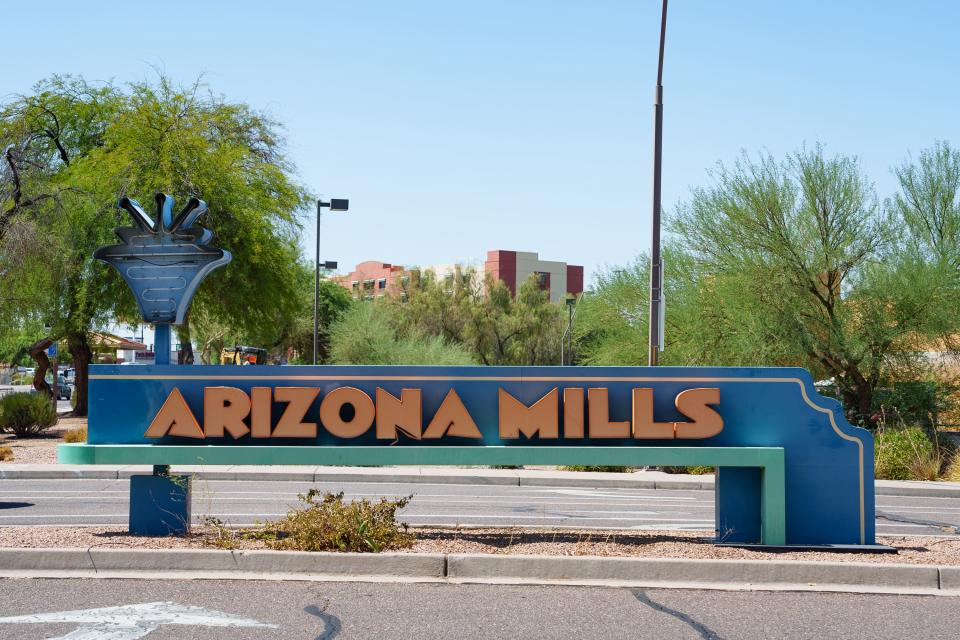Metro Phoenix malls calls to police range from place to place
Police get called to malls across the Valley regularly, but the reasons vary from place to place and that doesn't always mean that crime is more prevalent in one mall over another.
The types of malls in the Valley range from indoor malls to outdoor shopping centers, and each has its own levels of reported crimes and issues with public safety. The Arizona Republic collected data on calls to police and visitor data that show where malls have higher rates of reporting than others.
Recently, a shoplifting caused an evacuation of Arizona Mills. Over the last four years there have been at least four shootings in malls across the Valley. One man was sentenced in July for fatally shooting a 15-year-old boy.
Reporting Rates
According to data provided by Placer.ai, which was used to identify the biggest malls' visitor numbers, and calls for service data provided by local police departments, the rate of police activity at the Valley's biggest malls varies.
The rate of calls per 100,000 visitors in 2022 stacks up the following way:
Desert Sky Mall in west Phoenix at 75th Avenue and Thomas Road - 33.3
Christown Spectrum Mall at 17th Avenue and Bethany Home Road - 31.7
Scottsdale Fashion Square at Camelback Road and Goldwater Boulevard - 29.14
Tempe Marketplace at Rio Salado Parkway and McClintock Drive - 25.44
Arizona Mills at Baseline Road and Interstate 10 - 18.51
Arrowhead Towne Center at 75th Avenue and Bell Road - 9.98
The most common types of calls to malls are for shoplifting, theft, car accidents, welfare checks and alarms going off.
Arrowhead, Scottsdale Fashion Square and Tempe Marketplace get some of the most visitors than any of the other malls.
But the rate of calls to Arrowhead is significantly lower than the other two.
Desert Sky gets more police calls per visitor than any other mall.
Meet the ringmasters: On the creepiest block in metro Phoenix, it's Halloween year-round
Cause to call
Michael Scott, clinical professor and director of the Center for Problem-Oriented Policing at Arizona State University, explained that a large volume of calls to police doesn't always mean more crime.
The “reporting rate” can change, depending on each mall's policies for reporting to police. Some malls may encourage their customers to call the police directly when something happens, while others may try to deal with it internally, he said. That could drastically change the reporting rate.
He also mentioned that the immediate neighborhoods could also affect the rate.
"There are some shopping malls, for example, that sit in small towns, rural communities, which don't have a lot of high population and don't really have a lot of crime in the area, which might naturally leave that that mall at lower risk of crime as well," he said.

Another factor is the types of shops found in the malls. Some places can carry items or provide services to clients that statistically have higher incidents of crime or police response tied to them.
For example, bars would probably have more incidents than hospitals or medical centers, he said.
He highlights that more and more malls have been turning towards redevelopment in order to compete.
They have to include not just shops but entertainment, dining and housing, he said.
MetroCenter, one of Phoenix's oldest malls, closed in the summer of 2021 and has since begun a redevelopment in which some of the features that Scott described are being worked into its design.
MetroCenter's new face
Before it closed, MetroCenter had a calls-to-police rate of about 35 per 100,000 visitors.
Shops began to close over the last decade that the mall was open.
Jessica Estrada, who lives in the area of the mall, explained that it lost its appeal to her as more and more shops closed up.
”It wasn’t the same, not like when I was in high school,” she said.
The emptying shops made it feel a little less safe for her. Her visits shrunk from hour-long visits to quick 10 to 20-minute shopping sprints.
Scott also explained that when the number of people in malls shrinks, the number of potential crimes can both increase and decrease.
As malls lose foot traffic, it creates an atmosphere where there are fewer witnesses and fewer people to report a crime, but there are also fewer potential victims, and there is less merchandise. It’s hard to say what types of crimes rise in those situations.
Nationally, property crimes go underreported at most shopping centers and malls by a third, according to Scott.
But as malls become remodeled, Scott explains that they should consider public safety in their design and practice.
Some of that includes visibility and clear policy on what responsibilities the private owners have to their customer's safety and what should be handled by police.
Scott has shared some of his findings with the redevelopment project at the old Metro Center.
”I hope the changes they make bring back the feeling I used to get when visiting Metro,” Estrada said.
This article originally appeared on Arizona Republic: Police Calls to AZ Malls dependent on many factors

